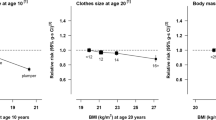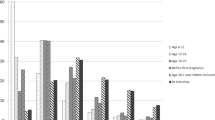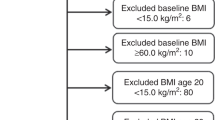Abstract
Background
It is believed that greater adiposity is associated with reduced risk of breast cancer in premenopausal but increased risk in postmenopausal women. However, few studies have evaluated these relationships among Black women or examined anthropometric measures other than near-diagnosis body mass index (BMI).
Purpose
This study investigated associations between measures of body size across the life course and breast cancer risk among Black and White women living in the US South.
Methods
We used data from the Carolina Breast Cancer Study, a population-based case–control study of invasive breast cancer in North Carolina women aged 20–74 years. We assessed nine body size variables, including age 10 relative weight; age 18 BMI; adult weight gain; “reference” BMI 1 year before interview; and post-diagnosis measured BMI and abdominal obesity measures.
Results
Among premenopausal Whites, heavier childhood relative weight was associated with decreased cancer risk [odds ratio (OR) 0.48 95 % confidence interval 0.33–0.70]. Among premenopausal Blacks, greater adult waist circumference and waist-to-hip ratio (WHR) were associated with increased risk [waist OR 1.40 (1.00–1.97) and high tertile WHR OR 2.03 (1.29–3.19)], with associations for WHR in a similar direction in Whites. Among postmenopausal women, recalled body size was not associated with risk, except for increased risk associated with adult weight gain among White non-hormone therapy users. ER/PR status and hormone therapy use also modified other associations.
Discussion
In this population, greater adult BMI was not associated with increased breast cancer risk, but some measures of early-life body size and abdominal obesity were associated with risk.
Similar content being viewed by others
References
SEER (2011) SEER cancer statistics review, 1975–2008. National Cancer Institute, Bethesda, MD [cited 2011]. http://seer.cancer.gov/csr/1975_2008
Zaloznik AJ (1995) Breast cancer stage at diagnosis: Caucasians versus Afro-Americans. Breast Cancer Res Treat 34(3):195–198
Shinagawa SM (2000) The excess burden of breast carcinoma in minority and medically underserved communities: application, research, and redressing institutional racism. Cancer 88(5 Suppl):1217–1223
Flegal KM, Carroll MD, Kit BK, Ogden CL (2012) Prevalence of obesity and trends in the distribution of body mass index among US adults, 1999–2010. J Am Med Assoc 307(5):491–497
World Cancer Research Fund/American Institute for Cancer Research (2010) Food, nutrition, physical activity, and the prevention of breast cancer. American Institute for Cancer Research, Washington, DC
Cheraghi Z, Poorolajal J, Hashem T, Esmailnasab N, Doosti Irani A (2012) Effect of body mass index on breast cancer during premenopausal and postmenopausal periods: a meta-analysis. PLoS One 7(12):e51446
Sexton KR, Franzini L, Day RS, Brewster A, Vernon SW, Bondy ML (2011) A review of body size and breast cancer risk in Hispanic and African American women. Cancer 117(23):5271–5281
Hall IJ, Newman B, Millikan RC, Moorman PG (2000) Body size and breast cancer risk in black women and white women: the Carolina Breast Cancer Study. Am J Epidemiol 151(8):754–764
Adams-Campbell LL, Kim KS, Dunston G, Laing AE, Bonney G, Demenais F (1996) The relationship of body mass index to reproductive factors in pre- and post-menopausal African-American women with and without breast cancer. Obes Res 4(5):451–456
Schatzkin A, Palmer JR, Rosenberg L, Helmrich SP, Miller DR, Kaufman DW et al (1987) Risk factors for breast cancer in black women. J Natl Cancer Inst 78(2):213–217
Zhu K, Caulfield J, Hunter S, Roland CL, Payne-Wilks K, Texter L (2005) Body mass index and breast cancer risk in African American women. Ann Epidemiol 15(2):123–128
Berstad P, Coates RJ, Bernstein L, Folger SG, Malone KE, Marchbanks PA et al (2012) A case–control study of body mass index and breast cancer risk in white and African-American women. Cancer Epidemiol Biomark Prev 19(6):1532–1544
Palmer JR, Adams-Campbell LL, Boggs DA, Wise LA, Rosenberg L (2007) A prospective study of body size and breast cancer in black women. Cancer Epidemiol Biomark Prev 16(9):1795–1802
Baer HJ, Colditz GA, Rosner B, Michels KB, Rich-Edwards JW, Hunter DJ et al (2005) Body fatness during childhood and adolescence and incidence of breast cancer in premenopausal women: a prospective cohort study. Breast Cancer Res 7(3):R314–R325
Harris HR, Tamimi RM, Willett WC, Hankinson SE, Michels KB (2011) Body size across the life course, mammographic density, and risk of breast cancer. Am J Epidemiol 174(8):909–918
Newman B, Moorman PG, Millikan R, Qaqish BF, Geradts J, Aldrich TE et al (1995) The Carolina Breast Cancer Study: integrating population-based epidemiology and molecular biology. Breast Cancer Res Treat 35(1):51–60
Weinberg CR, Sandler DP (1991) Randomized recruitment in case–control studies. Am J Epidemiol 134(4):421–432
Weinberg CR, Wacholder S (1990) The design and analysis of case–control studies with biased sampling. Biometrics 46(4):963–975
World Health Organization (1995). Physical status: the use and interpretation of anthropometry. Report of a WHO Expert Committee. World Health Organization technical report series 854:1–452. PubMed PMID: 8594834. Epub 1995/01/01. eng
Expert panel on the identification, evaluation, and treatment of overweight in adults (1998) Clinical guidelines on the identification, evaluation, and treatment of overweight and obesity in adults: executive summary. Am J Clin Nutr 68(4):899–917
Moorman PG, Kuwabara H, Millikan RC, Newman B (2000) Menopausal hormones and breast cancer in a biracial population. Am J Public Health 90(6):966–971
Rosner B, Colditz GA (2011) Age at menopause: imputing age at menopause for women with a hysterectomy with application to risk of postmenopausal breast cancer. Ann Epidemiol 21(6):450–460
Hernan MA, Hernandez-Diaz S, Robins JM (2004) A structural approach to selection bias. Epidemiology 15(5):615–625
Glymour MM, Weuve J, Berkman LF, Kawachi I, Robins JM (2005) When is baseline adjustment useful in analyses of change? An example with education and cognitive change. Am J Epidemiol 162(3):267–278
Hall IJ, Moorman PG, Millikan RC, Newman B (2005) Comparative analysis of breast cancer risk factors among African-American women and White women. Am J Epidemiol 161(1):40–51
Ahlgren M, Melbye M, Wohlfahrt J, Sorensen TI (2004) Growth patterns and the risk of breast cancer in women. N Engl J Med 351(16):1619–1626
De Stavola BL (2004) Childhood growth and breast cancer. Am J Epidemiol 159(7):671–682
Magnusson C, Baron J, Persson I, Wolk A, Bergstrom R, Trichopoulos D et al (1998) Body size in different periods of life and breast cancer risk in post-menopausal women. Int J Cancer Journal international du cancer 76(1):29–34
De Stavola BL, dos Santos Silva I, McCormack V, Hardy RJ, Kuh DJ, Wadsworth ME (2004) Childhood growth and breast cancer. Am J Epidemiol 159(7):671–682
Berkey CS, Frazier AL, Gardner JD, Colditz GA (1999) Adolescence and breast carcinoma risk. Cancer 85(11):2400–2409
Hilakivi-Clarke L, Forsen T, Eriksson JG, Luoto R, Tuomilehto J, Osmond C et al (2001) Tallness and overweight during childhood have opposing effects on breast cancer risk. Br J Cancer 85(11):1680–1684
Le Marchand L, Kolonel LN, Earle ME, Mi MP (1988) Body size at different periods of life and breast cancer risk. Am J Epidemiol 128(1):137–152
Michels KB, Terry KL, Willett WC (2006) Longitudinal study on the role of body size in premenopausal breast cancer. Arch Intern Med 166(21):2395–2402
Suzuki R, Iwasaki M, Inoue M, Sasazuki S, Sawada N, Yamaji T et al (2011) Body weight at age 20 years, subsequent weight change and breast cancer risk defined by estrogen and progesterone receptor status: the Japan public health center-based prospective study. Int J Cancer Journal international du cancer 129(5):1214–1224
Vrieling A, Buck K, Kaaks R, Chang-Claude J (2010) Adult weight gain in relation to breast cancer risk by estrogen and progesterone receptor status: a meta-analysis. Breast Cancer Res Treat 123(3):641–649
Carey LA, Perou CM, Livasy CA, Dressler LG, Cowan D, Conway K et al (2006) Race, breast cancer subtypes, and survival in the Carolina Breast Cancer Study. JAMA 295(21):2492–2502
Jain RB (2010) Regression models to predict corrected weight, height and obesity prevalence from self-reported data: data from BRFSS 1999–2007. Int J Obes (Lond) 34(11):1655–1664
Bandera EV, Chandran U, Zirpoli G, Gong Z, McCann SE, Hong CC et al. (2013) Body fatness and breast cancer risk in women of African ancestry. BMC Cancer 13:475
Amadou A, Ferrari P, Muwonge R, Moskal A, Biessy C, Romieu I et al (2013) Overweight, obesity and risk of premenopausal breast cancer according to ethnicity: a systematic review and dose–response meta-analysis. Obes Rev 14(8):665–678
John EM, Sangaramoorthy M, Phipps AI, Koo J, Horn-Ross PL (2011) Adult body size, hormone receptor status, and premenopausal breast cancer risk in a multiethnic population: the San Francisco Bay Area breast cancer study. Am J Epidemiol 173(2):201–216
Hu FB (2008) Obesity and cancer. In: Hu FB (ed) Obesity epidemiology. Oxford University Press, New York, pp 174–195
Schapira DV, Clark RA, Wolff PA, Jarrett AR, Kumar NB, Aziz NM (1994) Visceral obesity and breast cancer risk. Cancer 74(2):632–639
Rose DP, Komninou D, Stephenson GD (2004) Obesity, adipocytokines, and insulin resistance in breast cancer. Obes Rev 5(3):153–165
Raikkonen K, Matthews KA, Kuller LH (1999) Anthropometric and psychosocial determinants of visceral obesity in healthy postmenopausal women. Int J Obes Relat Metab Disord 23(8):775–782
Bonora E, Micciolo R, Ghiatas AA, Lancaster JL, Alyassin A, Muggeo M et al (1995) Is it possible to derive a reliable estimate of human visceral and subcutaneous abdominal adipose tissue from simple anthropometric measurements? Metab Clin Exp 44(12):1617–1625
Moorman PG, Newman B, Millikan RC, Tse CK, Sandler DP (1999) Participation rates in a case-control study: the impact of age, race, and race of interviewer. Ann Epidemiol 9(3):188–195
Harris HR, Willett WC, Terry KL, Michels KB (2011) Body fat distribution and risk of premenopausal breast cancer in the Nurses’ Health Study II. J Natl Cancer Inst 103(3):273–278
Rastogi S, Johnson TD, Hoeffel EM, Drewery Jr. MP (2011) The Black population: 2010. In: Bureau USC (ed) Washington, DC: U.S. Department of Commerce
Acknowledgments
This research was funded in part by the University Cancer Research Fund of North Carolina and the National Cancer Institute Specialized Program of Research Excellence (SPORE) in Breast Cancer (NIH/NCI P50-CA58223). Dr. Robinson was supported by the National Cancer Institute (1K01CA172717-01). Dr. Troester was supported by the following grants from the National Institutes of Health: U01 ES019472; P30 ES010126; P30 DK056350; and P50 CA151135. This research was supported in part by a grant from the National Institute of Environmental Health Sciences (P30ES010126). We are grateful to the Carolina Population Center (R24 HD050924) for general support.
Conflict of interest
The authors declare that they have no conflicts of interest.
Author information
Authors and Affiliations
Corresponding author
Electronic supplementary material
Below is the link to the electronic supplementary material.
Rights and permissions
About this article
Cite this article
Robinson, W.R., Tse, C.K., Olshan, A.F. et al. Body size across the life course and risk of premenopausal and postmenopausal breast cancer in Black women, the Carolina Breast Cancer Study, 1993–2001. Cancer Causes Control 25, 1101–1117 (2014). https://doi.org/10.1007/s10552-014-0411-5
Received:
Accepted:
Published:
Issue Date:
DOI: https://doi.org/10.1007/s10552-014-0411-5




